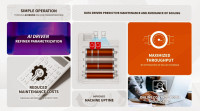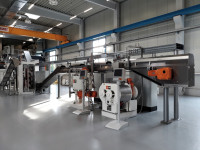Artificial Intelligence (AI) has become increasingly important in recent years and is used in many areas of industry. AI also offers enormous potential for optimising production processes in the chocolate industry. From the processing of the cocoa bean to the finished chocolate bar, numerous complex steps are required that can be made more efficient, more sustainable and of higher quality using intelligent algorithms.
AI is based on several fundamental principles, including machine learning, pattern recognition, reinforcement learning and adaptivity. To use these technologies successfully, you not only need specialised algorithms, but also a solid database with process-relevant parameters and iterative learning phases that improve predictions and optimisations. The integration of AI becomes particularly challenging when the aim is not only to analyse existing processes, but also to actively control and optimise them by adjusting the system parameters.
In the chocolate industry, the implementation of AI is still in a transitional phase. Areas with a good data basis, such as the quality control of raw and finished goods, capacity planning or demand forecasts, are already benefiting from AI systems. Progress is also being made in individual production steps.
One example in cocoa production is the separation of cocoa shells and nibs, which can be optimised using machine learning by automatically adjusting the break size to minimise the fines content and thus optimise the yield and improve the quality of the nibs in relation to the shell content. Fat content control during pre-grinding is also a promising approach for making downstream processes more effective and ensuring normalisation of the cocoa mass. In addition, the cocoa fermentation index can be analysed, which has a direct influence on grinding in terms of throughput in relation to fineness and temperature during grinding.
Examples of a lack of data and smart sensor technology in the field of cocoa processing include the alkalisation of cocoa for cocoa powder colour adjustment, where there is currently a lack of suitable sensors to directly record process-relevant data such as colour development in real time during alkalisation. Without this data, it is not possible to develop an algorithm that enables inline adjustment of process parameters such as steam pressure, air volume and/or time in order to achieve a specific powder colour with varying raw materials within this individual process step.
In addition to the partial lack of information from the individual process analysis, the data basis for the overall plant analysis is often missing in order to enable AI across the board.
In the example of chocolate production, many process steps up to conching can already be easily measured with sensors, which facilitates AI integration. For example, plasticity in the mixer and pre-grinding can be monitored in order to control the consistency of the product. Roller coverage and pattern recognition, e.g. using the ‘Stripe Detection Cockpit’, as well as fineness measurement in the rolling mill also offer valuable opportunities for AI-supported process optimisation in terms of throughput in relation to target fineness. The interactions between plasticity, roll coverage and fineness can be recorded by AI in order to make automated adjustments in the future. Of course, there is further potential for optimisation with regard to the development of a specific algorithm for fine grinding, as a large number of parameters can be set in this process step.
Particularly in conching, there is a lack of ‘smart sensors’ and algorithms to replace the mostly time-based control of the conching process with a control system based on quality criteria. Some innovative approaches already exist to improve this area: On the one hand, simulation software is being worked on to understand the interrelationships, which can be seen as the basis for AI control, and on the other hand, sensor technology, such as the ‘Flavour Monitoring Cockpit (FMC)’, which can monitor conching performance cost-effectively by analysing the organic gas composition as well as the moisture in the conche headspace. This allows quality fluctuations to be recognised at an early stage and conching times to be individually adjusted. This process could serve as a bridging technology to enable fully AI-supported control of the conching parameters with regard to chocolate rheology and thus fat optimisation and flavour optimisation over time in the near future.
The introduction of AI in the chocolate industry offers great opportunities for increasing efficiency, improving quality and sustainable production. Current applications show promising results, especially in process monitoring and optimisation. Nevertheless, there are challenges, particularly with regard to insufficient data availability, a lack of sensors and the high level of process complexity. Future developments could overcome these obstacles and enable a deeper integration of AI in chocolate production. There is further potential for innovation, particularly in the area of real-time process control and intelligent machine networking. In the long term, AI could optimise the entire interaction of production machines and thus make a decisive contribution to efficiency, quality and sustainability in the chocolate industry.





